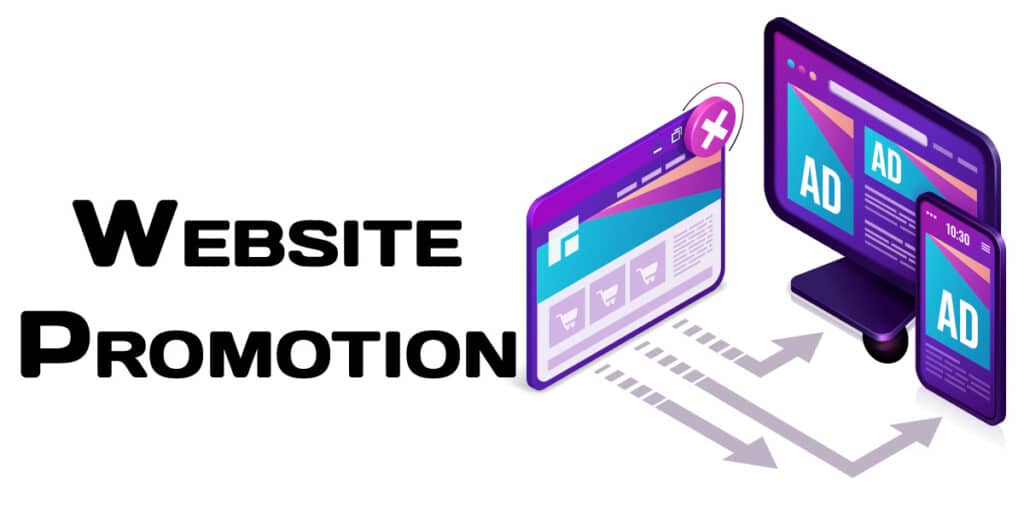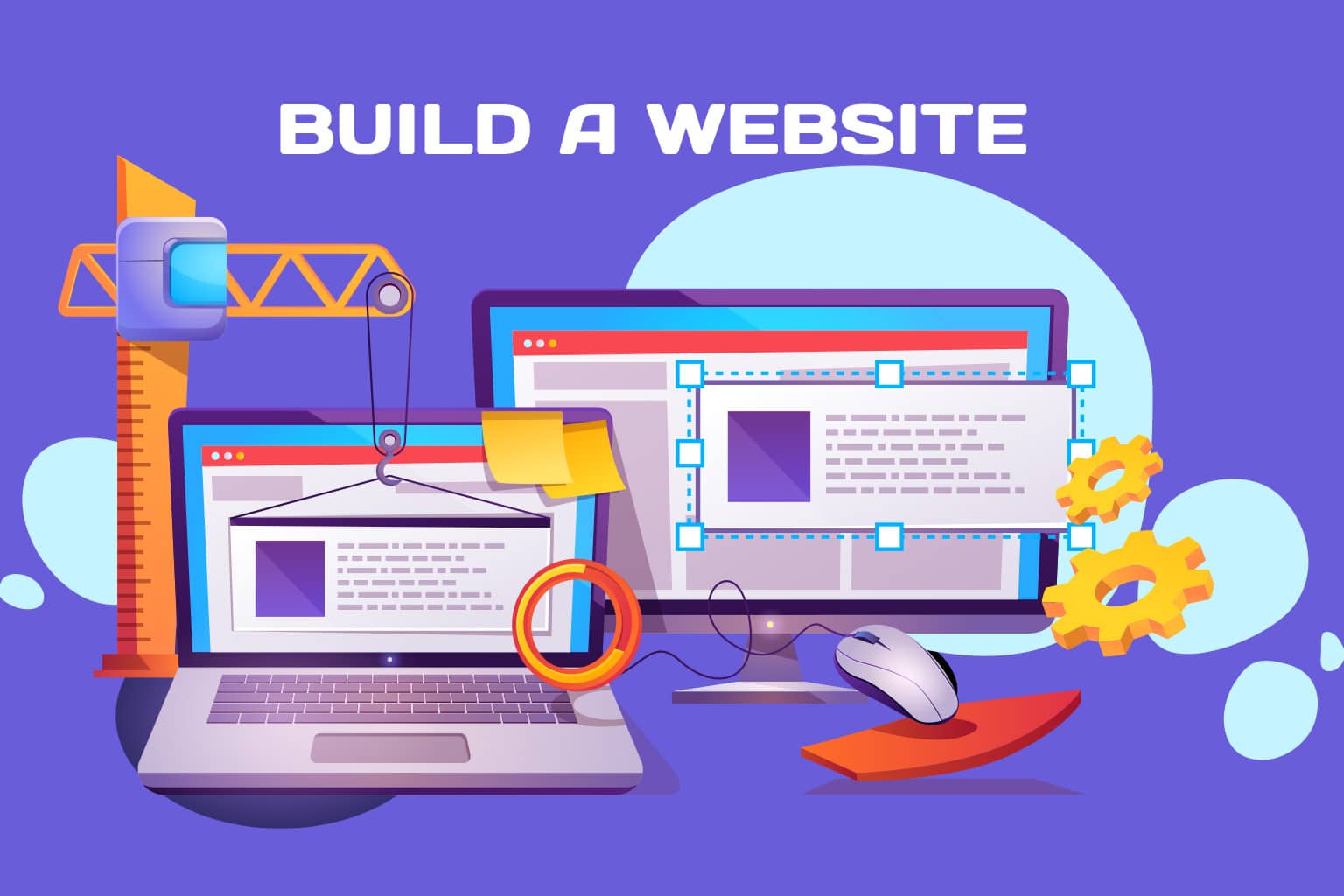In today’s digital world, having a strong online presence is more important than ever. With countless businesses vying for consumers’ attention, an eye-catching, user-friendly website can make all the difference in setting your brand apart from the competition.
This comprehensive guide will walk you through the entire process to Build a Website, from initial planning to ongoing maintenance. We’ve designed this guide to be accessible to everyone, regardless of your technical expertise or previous experience in web design.
Throughout this guide, we’ll cover essential topics such as defining your target audience, selecting a domain name and hosting provider, designing your own website or blog page’s layout and appearance, creating high-quality content, and implementing effective SEO strategies.
We’ll also explore key website features, engaging your audience, social media integration, and analytics, to ensure your site is as functional as it is visually appealing when learning how to create a website.
Whether you’re a small business owner looking to expand your customer base, an aspiring blogger hoping to share your passion with the world on a personal blog, a creative professional showcasing your portfolio, on a local store owner looking to sell online with an e-commerce website, this guide will help you easily navigate the complexities of website creation.
So, let’s dive in and start building your own website from the ground up!
Planning How to Create a Website in Simple Steps

Defining your target audience
Before diving into how to create your own website, it’s essential to identify and understand your target audience.
By pinpointing their demographics, needs, and preferences, you’ll be better equipped to design a site that speaks to them and keeps them coming back for more.
Identifying customer demographics: Begin by considering the age, gender, location, income level, and other factors that define your ideal customer.
For example, if you’re opening an online store that sells eco-friendly products, your target audience might be environmentally-conscious individuals between the ages of 25 and 45. Creating detailed customer personas can help you better visualize your audience and tailor your website to meet their specific needs.Understanding customer needs and preferences: Once you have a clear picture of your target audience, think about what they’re looking for in a website. Do they value fast loading times and easy navigation, or are they more drawn to visually appealing design elements? By putting yourself in your audience’s shoes, you can create a website that meets their expectations and keeps them engaged.
Establishing website goals
With your target audience in mind, it’s time to set some goals for your website. Clearly defined goals will not only guide your design and content decisions but also help you measure your site’s success.
Conversion objectives: Depending on your business or niche, your conversion objectives may vary. For an e-commerce store, this might mean increasing sales and average order value. For a professional services website, your goal could be generating more leads and inquiries. And for a blog, you might aim to grow your email subscriber list. Whatever your conversion goals, make sure they’re specific, measurable, and attainable.
Branding and authority building: Your website is an extension of your brand, so it should accurately represent your business and its values. Consider how you can use your site to build credibility and establish yourself as an authority in your industry. This might involve showcasing customer testimonials, sharing informative and engaging content, or offering free resources that demonstrate your expertise.
Creating a content strategy
A successful website hinges on a robust content strategy. This involves planning the type of content you’ll create, determining how often you’ll publish new material, and outlining how you’ll promote your content to reach your target audience.
Content types: Identify the types of content you want to create, such as blog posts, videos, infographics, or case studies. Consider what formats will resonate with your audience and help you achieve your goals.
Content calendar: Develop a content calendar to plan and schedule your content creation efforts. This will help you stay organized and ensure you’re consistently publishing new material.
Content promotion: Determine how you’ll promote your content to reach your target audience. This might include sharing it on social media, sending it out via email newsletters, or partnering with influencers in your industry.
Choose a Memorable Domain Name
Selecting the perfect domain name for your website is crucial, as it represents your brand online and helps people find your site. A well-chosen domain name should be memorable, easy to spell, and related to your website’s content or business. Furthermore, you can opt for a variety of top-level domains (TLDs) like .com, .net, or .org to suit your needs.
For more tips on how to choose a domain name that will resonate with your target audience, visit our guide on choosing a domain name.

Importance of a strong domain name
Your domain name often creates the first impression potential visitors have of your website. An unforgettable and pertinent domain name helps solidify your brand identity, allowing customers to quickly recognize and associate your website with your business.
Moreover, a strong domain name can positively influence your website’s search engine rankings, making it more likely for users to discover your site.
Tips for Selecting an effective domain name
Keep these guidelines in mind when choosing your domain name:
Keep it short and simple: Aim for a domain name that is concise and easy to spell. A shorter domain is not only more memorable but also reduces the likelihood of typos or misspellings.
Be relevant and descriptive: Choose a domain name that reflects your business or niche. This can help users quickly understand what your website is about and build trust in your brand.
Avoid numbers and hyphens: While numbers and hyphens might make your domain name unique, they can be confusing and difficult to remember. Stick to letters for better memorability and readability.
Use an appropriate domain extension: The most popular domain extension is .com, but you may also consider other options such as .net, .org, or industry-specific extensions like .shop or .photography.
Registering your domain name
Once you’ve decided on the ideal domain name, the next step is registering a domain name to secure it for your use. This process involves selecting a reputable domain registrar like GoDaddy, Namecheap, or Google Domains, which are companies that manage the reservation of domain names.
The cost of registering a domain name varies depending on the TLD and the registrar you choose. To learn more about domain registrars and how to register your domain name, explore our comprehensive guide on registering a domain name.
Selecting a Hosting Provider
After securing your domain name, you’ll need a reliable web hosting provider to store your website’s files and make them accessible to visitors.
A web hosting provider is responsible for storing your website’s files and making them accessible to visitors on the internet. Choosing the right web host provider is essential for your website’s performance, security, and reliability.

Factors to consider when choosing a hosting provider
When evaluating web hosting services and providers, consider the following factors:
Speed and performance: A fast-loading website provides a better user experience and can improve your search engine rankings. Look for hosting providers that offer solid-state drives (SSDs), content delivery networks (CDNs), and other features that enhance speed and performance.
Security: Ensure your hosting provider takes security seriously by offering features such as malware scanning, firewalls, and secure sockets layer (SSL) certificates.
Customer support: Choose a hosting provider with a reputation for excellent customer service, as they’ll be your first point of contact for any issues or questions related to your website.
Pricing and scalability: Compare the pricing and features of different hosting plans to find one that suits your budget and needs. Also, consider whether the provider offers the flexibility to upgrade or downgrade your plan as your website grows or changes.
Types of hosting plans
Shared hosting: In a shared hosting environment, your website shares server resources with other websites. This is the most affordable option, but it can lead to slower performance and limited scalability.
Virtual private server (VPS) hosting: With VPS hosting, your website still shares a server with other sites, but it has its own dedicated portion of the server’s resources. This offers better performance and customization options than shared hosting, but it may be more expensive.
Dedicated hosting: Dedicated hosting involves renting an entire server exclusively for your website. This provides optimal performance, security, and customization, but it’s significantly more expensive than shared or VPS hosting and may require more technical expertise to manage.
Cloud hosting: Cloud hosting utilizes a network of interconnected servers to host your website, allowing it to automatically scale resources as needed. This option offers excellent performance, scalability, and reliability, but pricing can be less predictable due to the pay-as-you-go model.
Recommended hosting providers
There are numerous web hosting providers available, offering a wide range of hosting plans, such as shared, VPS, dedicated, and cloud hosting. Each hosting type has its own advantages and is suited to different website requirements.
To choose the best web hosting provider and plan for your website, check out our in-depth guide on web hosting providers and their offerings.

DIY or a Website Builder: Choosing the Right Approach for Your Needs
When learning how to create a website, one of the key decisions you’ll need to make is whether to build your site from scratch or use a website builder.
Each approach has its pros and cons, and the best choice for you will depend on your specific needs and technical expertise.
Building a website from scratch provides more flexibility and customization options, allowing you to create a unique online presence tailored to your brand’s identity.
However, this approach may require advanced coding skills and can be time-consuming. Additionally, creating a website from scratch can be more challenging for those who lack web design and development experience.
On the other hand, website builders have become increasingly popular as a more accessible and user-friendly alternative to building a website from scratch.
Website builders like Wix, Squarespace, and WordPress offer pre-designed templates and user-friendly drag-and-drop interfaces, making it easier for those with limited coding experience to create a professional-looking website.
These website builders also provide a wide range of features and tools to help you customize your site, such as e-commerce capabilities, blogging platforms, and image galleries.
There are several advantages to using a website builder for your project. First and foremost, website builders save you time and effort by providing an all-in-one solution for creating and managing your website.
With a website builder, you won’t need to worry about coding, as most website builders offer easy-to-use tools and templates that require little to no coding experience.
Another benefit of using a website builder is the availability of support and resources. Most website builders offer comprehensive tutorials, guides, and customer support to help you create and maintain your website. Additionally, website builders often include regular updates and security features, ensuring that your website stays up-to-date and secure.
However, it’s essential to consider the potential limitations of website builders as well. While website builders offer many customization options, they may not provide the same level of flexibility as building a website from scratch. Some website builders may also have limitations when it comes to advanced features or integrations with third-party tools.
In conclusion, when deciding between a DIY approach or using a website builder, it’s essential to weigh the benefits and drawbacks of each option. If you have advanced coding skills and desire a high level of customization, building a website from scratch might be the right choice for you. However, if you prefer a more accessible, user-friendly solution with plenty of support and resources, a website builder may be the better option for your needs.
Selecting a template or theme
If you opt for a website builder, choose a template or theme that matches your brand identity and appeals to your target audience. Ensure the template is responsive, meaning it automatically adjusts to fit different screen sizes on various devices.
Customizing your design
Personalize your chosen template by adjusting colors, fonts, and layout to match your brand’s aesthetic. Ensure your website is visually appealing and easy to navigate, and don’t be afraid to seek feedback from friends, colleagues, or your target audience.
Incorporating essential website features
As you build your website, consider incorporating key features that enhance its functionality and user experience. Some examples include:
Contact forms: Allow visitors to easily get in touch with you by including a contact form on your website.
Social media integration: Connect your website to your social media profiles to encourage visitors to follow and engage with you on various platforms.
Analytics: Implement tools like Google Analytics to track your website’s performance and gain insights into visitor behavior.
Mobile optimization: Ensure your website looks and functions well on mobile devices, as a growing number of users access the internet primarily through smartphones and tablets.
Creating High-Quality Content
When figuring out how to create a website that engages your audience, it’s essential to focus on crafting compelling copy. The text on your website should be clear, concise, and informative, providing value to your visitors and encouraging them to take action.
Writing for your target audience
As you create content for your website, keep your target audience in mind. Write in a tone and style that resonates with them, and addresses their needs, interests, and pain points. This will help you foster a connection with your audience and establish your website as a trusted resource.
Incorporating SEO best practices
As you learn how to create your first website here, it’s crucial to understand and implement on-page SEO techniques to improve your site’s visibility in search engine results.
By incorporating relevant keywords, crafting descriptive and enticing meta titles and descriptions, and using headings to break up your text and improve readability. These techniques will help search engines understand and index your content, making it more likely to rank higher in search results.
Ensuring readability and accessibility
To make your content more enjoyable and accessible to your readers, focus on readability. Use short paragraphs, clear and concise language, and bullet points or numbered lists to break up information. Also, consider accessibility features such as alt text for images and transcripts for videos.
Using multimedia elements
Enhance your content by incorporating multimedia elements such as images, videos, infographics, or audio clips. These elements can make your content more engaging and shareable, helping to attract and retain visitors.
Regularly updating your content
Keep your website fresh and relevant by regularly updating and adding new content. This not only demonstrates your commitment to providing value to your audience but also signals to search engines that your website is active and up-to-date, which can boost your rankings.
Utilizing AI and AI Writing Tools for Content Creation
In recent years, artificial intelligence (AI) and AI writing tools have emerged as valuable resources for creating high-quality content. These tools can help streamline the content creation process, save time, and ensure your website’s content is engaging, informative, and well-written.
AI writing tools, such as OpenAI’s GPT, JasperAI or other content generation platforms, utilize advanced algorithms and natural language processing to generate human-like text based on the input provided. These tools can be used to create various types of content, including blog posts, product descriptions, social media updates, and more.

JasperAI is an advanced artificial intelligence writing assistant designed to help you create high-quality content effortlessly. This powerful tool harnesses the capabilities of natural language processing and machine learning to generate text that is coherent, engaging and tailored to your specific needs. From blog posts and social media content to research papers and marketing materials, JasperAI can save you time and effort while ensuring that your content stands out.
Discover more about how JasperAI can revolutionize your writing process and elevate your content creation game by visiting our comprehensive guide on this cutting-edge AI writing assistant.
There are several advantages to using AI writing tools for content creation:
Time-saving: AI writing tools can quickly generate content, allowing you to focus on other aspects of your website, such as design or marketing.
Consistency: AI writing tools can help maintain a consistent tone and style across your website, ensuring a cohesive brand identity.
Flexibility: AI writing tools can be used for a wide range of content types, making it easier to create diverse and engaging content for your website.
Keyword optimization: Some AI writing tools offer SEO features, such as keyword optimization, which can help improve your website’s search engine rankings.
However, it’s essential to note that AI-generated content may require editing and proofreading to ensure accuracy, readability, and relevance. Additionally, some AI writing tools may generate content that sounds too robotic or lacks a personal touch, which can be off-putting to your target audience.
To make the most of AI and AI writing tools, consider using them in conjunction with your own writing skills or those of a professional writer. This approach can help you strike the right balance between efficiency and personalization, resulting in high-quality content that engages your audience and showcases your brand’s unique voice.
By leveraging AI writing tools in your content creation process, you can save time, maintain consistency, and ultimately create engaging, informative content that appeals to your target audience and supports your website’s goals.
Promoting Your Own Website
Once your website is up and running, it’s essential to actively promote it to attract visitors and grow your online presence.
Content marketing is a vital aspect of promoting your website and involves creating valuable, relevant, and consistent content to attract and retain your target audience. By developing a content marketing strategy, you can showcase your expertise and drive traffic to your website, ultimately helping you learn how to create a website that’s successful and engaging.

Leveraging social media
Share your website and content on social media platforms such as Facebook, Instagram, Twitter, and LinkedIn. Engage with your audience by responding to comments and messages, participating in relevant groups or forums, and using hashtags to increase your visibility.
Email marketing
Build an email list by encouraging visitors to sign up for your newsletter or on a contact page, providing a valuable lead magnet in exchange for their email address. Regularly send out updates, promotions, and new content to keep your audience engaged and encourage them to visit your website.
Networking and partnerships
Collaborate with other businesses or influencers in your industry to tap into their audience and expand your reach. This could involve guest posting on their blog, hosting a joint webinar, or offering exclusive discounts to their followers.
Paid advertising
Consider using paid advertising options such as Google Ads, Facebook Ads, or Instagram Ads to drive traffic to your website. Be sure to target your ads to your specific audience and track your results to optimize your campaigns for maximum effectiveness.
Monitoring and analyzing your results
Use analytics tools like Google Analytics to track your website’s performance and gain insights into your audience’s behavior. Analyze your data to identify areas for improvement and adjust your promotional strategies as needed.
By following this comprehensive guide, you’ll be well on your way to building a successful business website that effectively showcases your business, engages your audience, and helps you achieve your online goals.
Maintaining and Updating Your Website
To ensure the ongoing success of your own website, it’s important to regularly maintain and update it. This not only keeps your content fresh and relevant but also helps to maintain optimal performance, security, and user experience.
Regularly testing your website
Routinely test your website for any broken links, outdated content, or technical issues. This ensures your visitors have a seamless experience and prevents potential problems from impacting your website’s performance and search engine rankings.
Updating software and plugins
If you’re using a content management system (CMS) like WordPress or a website builder, make sure to keep your software and plugins up-to-date. Regular updates help to maintain the security, functionality, and compatibility of your website.
Backing up your website
Regularly back up your website to protect it from potential data loss due to technical issues or cyberattacks. Most web host providers offer automatic backup solutions, but you can also use a third-party backup service or manually save copies of your website files.
Monitoring website performance
Use tools like Google PageSpeed Insights or GTmetrix to monitor your website’s loading speed and performance. If you notice a decline in performance, investigate and address any issues, such as large images or outdated plugins, that may be contributing to the problem.
Staying current with industry trends
keep your website competitive and engaging, stay up-to-date with the latest trends and best practices in web design, content creation, and digital marketing. Continuously look for ways to improve your website and provide value to your audience.
Seeking feedback and making improvements
Actively seek feedback from your audience and peers to identify areas for improvement on your website. Be open to suggestions and continuously iterate on your design, content, and user experience to ensure your website remains effective and engaging.
By regularly maintaining and updating your website, you can ensure it continues to serve your business and audience effectively. Remember that your website is a living, evolving entity, and staying proactive in its care and development will help you achieve long-term success in your online endeavors.
Measuring Your Website’s Success
To gauge the effectiveness of your website and identify areas for improvement, it’s essential to measure your website’s success using various metrics and key performance indicators (KPIs). Here are some important metrics to track and analyze:
Website Traffic
Track the number of visitors to your website, as well as their sources, using tools like Google Analytics. This can help you determine which marketing channels are most effective at driving traffic and where to focus your promotional efforts.
Bounce rate
The bounce rate represents the percentage of visitors who leave your website after viewing just one page. A high bounce rate may indicate that your content isn’t engaging or that users aren’t finding what they’re looking for, signaling a need for improvement in your website’s layout or content.
Conversion rate
The conversion rate measures the percentage of visitors who complete a desired action on your website, such as making a purchase, signing up for a newsletter, or submitting a contact form. Tracking your conversion rate can help you evaluate the effectiveness of your website’s design, calls to action, and overall user experience.
Average session duration
This metric represents the average length of time a visitor spends on your website. A longer session duration typically indicates that your content is engaging and effectively holding the attention of your audience.
Pages per session
This metric reveals the average number of pages a visitor views during a single session on your website. A higher number of pages per session suggests that your website’s content and navigation effectively encourage users to explore your site further.
Returning visitors
The percentage of visitors who return to your website after their initial visit can provide insight into your website’s ability to engage and retain your audience. A higher percentage of returning visitors typically indicates that your content is valuable and resonates with your target audience.
By consistently monitoring and analyzing these metrics, you can identify trends, strengths, and weaknesses in your website’s performance. Use this information to inform your ongoing website maintenance, updates, and promotional efforts, ensuring your website remains an effective and engaging online presence for your business.
Adapting to Evolving Technology and Trends
As technology and trends continue to evolve, it’s crucial to adapt and innovate to keep your website relevant, engaging, and effective. Here are some strategies to help you stay ahead of the curve:
Keeping up with industry news
Stay informed about the latest developments in web design, content creation, digital marketing, and technology by following industry news sources, blogs, and social media channels. This will help you stay current with trends and best practices, enabling you to make informed decisions about your website’s ongoing development.
Adopting new technologies
As new technologies emerge, evaluate their potential benefits and applications for your website. For example, consider implementing chatbots to improve customer service, or explore the use of virtual reality or augmented reality to create immersive experiences for your visitors.
Prioritizing website accessibility
Ensure that your website is accessible to all users, regardless of their abilities or disabilities. Follow the Web Content Accessibility Guidelines (WCAG) to make web pages on your website more inclusive and user-friendly, and stay current with updates and new guidelines.
Embracing mobile-first design
With the growing prevalence of mobile devices, it’s essential to prioritize mobile design and optimization. Ensure your website looks and functions well on a variety of devices and screen sizes, and consider adopting a mobile-first design approach to cater to the increasing number of mobile users.
Focusing on user experience (UX)
Continuously evaluate and improve your website’s user experience by prioritizing intuitive navigation, fast loading times, and engaging content. Regularly seek feedback from your users and make data-driven decisions to optimize your website’s UX.
Participating in industry events and networking
Attend industry conferences, workshops, and networking events to stay informed about the latest trends, share ideas with peers, and learn from experts. This can help you gather insights and inspiration for your website and stay ahead of the competition.
By staying proactive and adaptable, you can ensure your website remains a valuable and engaging online presence for your business in the face of evolving technology and trends. Embrace change and innovation to keep your website at the forefront of your industry and continue to serve your audience effectively.
Enhancing Website Security
Protecting your website and its users is of paramount importance. With the ever-increasing threats of cyberattacks, it’s essential to prioritize website security and safeguard sensitive data. Here are some strategies to enhance the security of your website:
Keeping software and plugins updated
Regularly update your content management system (CMS), plugins, and themes to ensure you’re using the latest security patches and improvements. Outdated software can expose your website to vulnerabilities, making it easier for hackers to exploit.
Utilizing strong passwords and multi-factor authentication (MFA)
Implement strong, unique passwords for all administrative accounts and encourage users to do the same. Consider enabling multi-factor authentication for added security, requiring users to provide additional verification (such as a text message code) when logging in.
Implementing SSL encryption
Secure Socket Layer (SSL) encryption helps protect sensitive information transmitted between a user’s browser and your website. Obtain an SSL certificate and ensure your website uses HTTPS to encrypt data and reassure visitors that their information is secure.
Regularly backing up your website
Regularly create backups of your website to protect against data loss in the event of a cyberattack or technical issue. Store backups in a secure, off-site location and routinely test them to ensure they can be effectively restored.
Monitoring your website for security threats
Utilize security tools and plugins, such as Sucuri or Wordfence, to regularly scan your website for malware, vulnerabilities, and other security threats. Act promptly to address any issues and safeguard your website and its users.
Restricting user access and permissions
Limit the number of users with administrative access to your website, and only grant permissions to those who require them for their role. Regularly review user accounts and permissions, and promptly remove access for users who no longer need it.
By prioritizing website security and implementing these strategies, you can better protect your website, its users, and your business’s reputation. Regularly assess and update your security measures to stay ahead of evolving threats and maintain a secure online presence. To learn more about the best practices for securing your website and safeguarding your online presence, explore our in-depth guide on website security.
Leveraging Analytics to Improve Your Website
Utilizing website analytics tools can provide valuable insights into your website’s performance, user behavior, and areas for improvement. By leveraging these insights, you can make informed decisions to optimize your website and better serve your audience. Here are some strategies for using analytics to improve your website:
Setting up analytics tracking
If you haven’t already, set up tracking on your website using tools like Google Analytics or a similar platform. These tools can provide a wealth of information about your website’s traffic, user behavior, and more.
Defining goals and key performance indicators (KPIs)
Determine the primary objectives of your website, such as generating leads, driving sales, or increasing brand awareness. Establish KPIs related to these goals, like conversion rate or time on site, to help you measure your website’s success and guide your optimization efforts.
Analyzing user behavior
Delve into your analytics data to better understand how users interact with your website. Identify popular content, common navigation paths, and potential pain points or areas of confusion. Use these insights to inform your website’s design, content, and user experience.
Identifying traffic sources
Determine where your website’s traffic is coming from, whether it’s organic search, social media, referrals, or paid advertising. Focus on the channels that drive the most traffic and conversions, and optimize your marketing efforts accordingly.
A/B testing
Experiment with different website elements, such as headlines, images, or calls to action, to determine what resonates best with your audience. Use A/B testing tools to compare different versions of a web page or element and measure their impact on your KPIs.
Regularly reviewing and acting on your data
Continuously monitor your analytics data and make data-driven decisions to improve your website’s performance. Periodically review your goals and KPIs to ensure they remain relevant and aligned with your business objectives.
By leveraging analytics to inform your website optimization efforts, you can create a more effective and engaging online presence that better serves your audience and achieves your business goals. Stay proactive in analyzing and acting on your data to ensure your website remains a valuable asset in your digital strategy.
Frequently Asked Questions
The cost of building a website can vary greatly depending on your needs and preferences. Factors that influence the cost include your domain name, web host provider, website building platform or CMS, and any premium themes or plugins you choose to use. You may also need to consider additional costs for professional services such as web design, content creation, or marketing.
Overall, building a website can range from very low-cost (using a free domain name or inexpensive tools) to several thousand dollars (for custom-designed websites with professional services).
The time it takes to create a website depends on several factors, including the complexity of your site, your level of experience, and the amount of time you can dedicate to the project.
For a simple website, it’s possible to have a basic version up and running in a matter of hours or days. However, more complex websites, or those built from scratch, can take several weeks or even months to complete.
Remember that building a website is an ongoing process, and you’ll need to continually update and improve your site over time.
While knowing how to code can be helpful when building a website, it’s not necessary for most projects. Many website-building platforms and content management systems, such as WordPress or Wix, offer user-friendly interfaces and drag-and-drop tools that make it easy to create a website without any coding knowledge.
There are also numerous pre-built themes and templates available to help you design your site quickly and efficiently.
Many people successfully build their websites without the help of a professional. With the variety of user-friendly website-building platforms, templates, and online resources available, it’s entirely possible to create a website on your own.
However, if you have a more complex project, limited time, or simply prefer to have professional assistance, you may choose to hire a web designer and a web developer yourself, or a digital marketing agency to help you with your website.
Driving traffic to your website requires a combination of strategies, including search engine optimization (SEO), content marketing, social media promotion, and paid advertising.
By optimizing your website for search engines, creating valuable and engaging content, and promoting your site through various channels, you can increase your online visibility and attract more visitors. Additionally, networking and building relationships within your industry can help you gain referrals and drive traffic to your site. Remember that driving traffic is an ongoing process that requires time and effort to achieve sustainable results.
Conclusion
Building a website may seem like a daunting task, but by following the comprehensive steps outlined in this guide, you can create an engaging and effective online presence for your business.
Recap of key steps in building a website
Define your website’s purpose and target audience
Plan your website’s structure and layout
Choose a domain name and web host provider
Select a website-building platform and theme
Create high-quality, relevant, and engaging content
Optimize your website for search engines (SEO)
Promote your website through various marketing channels
Maintain and update your website regularly
Measure your website’s success using analytics and KPIs
Adapt to evolving technology and trends
Enhance website security to protect your users and data
Leverage analytics to continuously improve your website
In today’s digital age, having a website is essential for any business looking to succeed and grow. A well-designed and engaging website can help you reach a wider audience, showcase your products or services, and establish your brand’s credibility and authority.
By following the steps and advice outlined in this guide, you can confidently embark on your website creation journey. Remember that building a website is an ongoing process that requires commitment and adaptability. As you learn and grow, your website will evolve with you, helping you achieve your business goals and connect with your target audience.
Don’t wait any longer – start creating your website today! With the right tools, knowledge, and determination, you can build an online presence that drives success for your business and serves as a valuable resource for your audience. Embrace the challenge and begin your journey toward a more prominent digital presence and brighter future.







